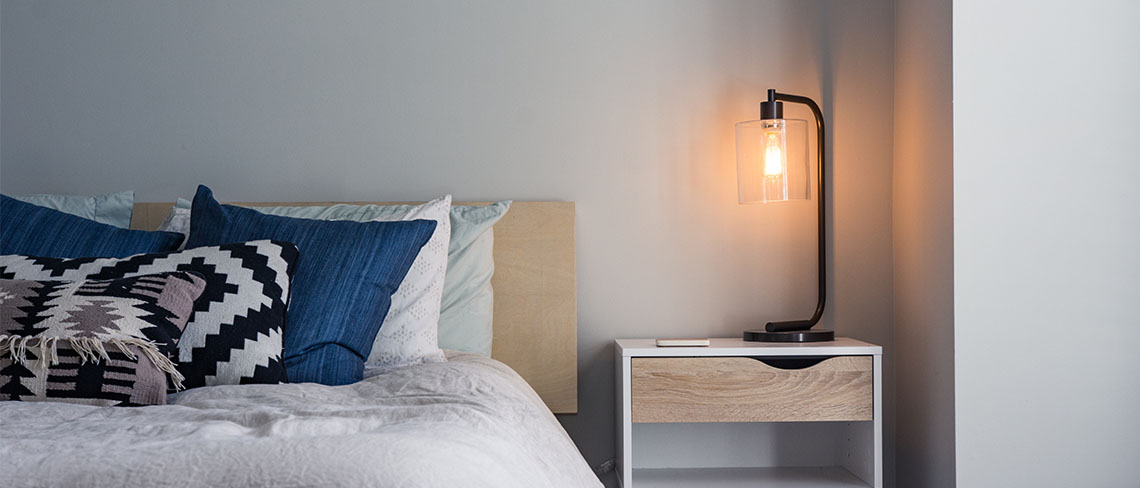
From colour advice to the perfect temperature, sleep experts at Tempur share tips on slumber-inducing bedroom design.
It’s easy to blame a stressful day at work, too much coffee, or simply not feeling tired as factors that might be preventing us from falling asleep at night. However, have you considered that it may be your bedroom design that is unsettling your slumber?
Evidence from The Sleep Council suggests bedroom environment is key to enjoying a restful night’s sleep[1] and factors such as wall colour, temperature, lighting and the use of gadgets can all impact sleep quality and quantity.
Here, sleep experts at Tempur have provided tips on how to ensure your bedroom is a calming oasis; a place to relax and unwind away from the business of daily life.
Tobin James, MD at Tempur, says: “The upcoming May Bank Holiday is the perfect time to re-decorate and switch up your bedroom, particularly if you’re having difficulty sleeping. Simple changes to the interior design can drastically improve sleep quality, leading to better mental and physical health.
“From choosing a calming wall colour to ensuring the temperature is just right, there are a number of ways to create the optimum bedroom environment for quality rest. Above all, we advise that the bedroom should mimic a cave: cool, quiet and dark.”
The psychology of colour
Re-painting is a simple and inexpensive way to update your bedroom. Forget bright or brash colours and select muted, calming palettes. Pastel tones such as light blue, soft pink, mild yellow, soothing green and calming grey, create tranquillity and help on the way to a good night’s sleep.
Red, orange and purple are no-go’s in the bedroom, as each increase heart rate and blood pressure, stimulating the body to stay awake and decreasing the body’s melatonin levels required to feel drowsy. If you simply must have bright colours, try adding these as an accent of colour rather than a block colour; a brightly coloured rug or cushions here and there won’t detract from the overall soothing tone.
Keep it cool and aired
Adding a thermostat or thermometer in your room will help you ensure the best temperature. To promote sleep, the bedroom should be a little cooler than the rest of the house (around 16-18°C) as our body heat naturally increases in the evening.
Bear in mind that young children and older people may require a slightly warmer bedroom temperature as their metabolic responses to cold are slower and less developed. It’s worth keeping extra layers, such as warm blankets on standby for cooler nights.
Ventilation and good air circulation in summer is paramount to sleeping well, so keep upstairs windows ajar overnight for a dose of fresh air.
Lighting
When it’s dark, our bodies naturally release melatonin, which relaxes our muscles and helps us drift off. Light seeping in will make us feel more awake, so invest in black-out blinds or lined curtains and ensure any chinks of light are well-covered.
An eye mask is a great way to block wake-inducing light when sleeping. And a dimmer lightbulb can be a far kinder way to wake you up than an alarm clock, as it will ease you out of sleep more gradually.
Declutter for added calmness
A busy space with lots of clutter will only add to your stress levels. In the bedroom, keep accessories to a minimum, cut down on books and personal items, and try to put shoes and clothes away in their proper place each day to avoid clutter build-up.
Utilise storage space wherever possible, such as divan drawers or an ottoman bed to keep bedding, towels and linens out of sight yet within easy reach and add floating shelves for a stylish storage solution.
Symmetry creates a calming effect, so try matching pairs of plants, photo frames and bedside tables either side of the bed for added balance.
Add greenery
Adding house plants is a simple way to bring the outdoors in and increase feelings of calm and relaxation. Easy-care varieties include cactuses, cheese plants, spider plants, ferns, aloe vera and yucca, which don’t require a lot of watering and thrive in normal house temperatures. In keeping with biophilic design (our human instinct which seeks out interaction with nature), choose natural (non-manmade) materials wherever possible, such as natural wood furniture, woven baskets for storage, and cotton bed linen.
The right bed
Choose the right mattress for your build and preference, bearing in mind that a mattress should be changed every eight-ten years. Your bed is by far the most significant component to achieving of a good night’s rest and must provide the right level of support for you.
Shared beds will need to be mutually comfortable and ensure good posture; a mattress too soft will cause slouching, whilst too firm can put pressure on hips, shoulders and blood flow.
A spritz of lavender or geranium sprayed on the pillow can also help to induce slumber.
Ban gadgets
Not strictly design related, but crucial when creating your sleep sanctuary nonetheless, is the matter of tech in the bedroom. Scrolling social media, replying to emails or checking news sites can be tempting when sleep is being evasive, but it’s important to remove tech when trying to sleep. LED and blue light from gadgets, phones, TVs, tablets, or computer screens can interfere with the body’s normal circadian rhythms which are crucial for sleep. Ensure everything is switched off or ban gadgets and screens from the bedroom altogether by keeping in a separate room.
For more information on Tempur, visit www.tempur.co.uk
-Ends-
For further press information, please contact:
Elsa Findlay/Jo Kendall/Julie Aguilera
T: +44 (0)20 3440 8930
E: [email protected]
About Tempur
Tempur researches, develops, engineers, manufactures and distributes mattresses, pillows and other sleep products to improve the sleep experience worldwide.
Tempur mattresses and pillows are made from a formulation of the brand’s proprietary pressure absorbing TEMPUR material, originally developed by NASA scientists in the 1970s to support and cushion astronauts during lift-off.
Tempur mattresses offer maximum quality, comfort, support, durability, value for money and aid a restorative night’s sleep.
Tempur is the no.1 mattress brand in Europe for customer satisfaction, with 9 out of 10 customers claiming they would buy Tempur again.
Tempur products can be purchased direct via the Tempur UK website, from any of thirteen Tempur brand stores and outlets, or from leading retailers including Dreams, John Lewis, Bensons for Beds, Furniture Village and Land of Beds and independent retailers.
Trusted and promoted by medical practitioners around the world, Tempur is the only mattress product recognised by NASA and certified by the Space Foundation.
Tempur is a subsidiary of Tempur Sealy International Inc.
Tempur – a mattress like no other.
Follow Tempur:
- Twitter: @TempurUK
- Facebook: @TempurUK
- Instagram: @tempur_uk
- YouTube: https://www.youtube.com/user/TempurUKonTV
[1] https://sleepcouncil.org.uk/perfect-sleep-environment/






